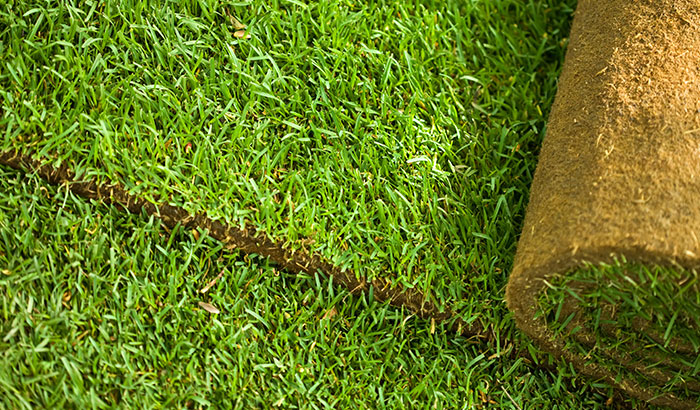If you are preparing to lay sod, there are a few tips that everyone should know to keep sod healthy and vibrant.
Laying sod can seem intimidating, but it’s actually a simple process that anyone can do. With the right tools and a little bit of know-how, you can easily create a beautiful, vibrant yard. Don’t let the fear of the unknown hold you back — by just following a few lawn care and landscaping tips, you can have the yard of your dreams.
Following these tips can help your new sod grow into a beautiful, healthy yard.
1.Water Your Sod Regularly, But Not Too Much
It’s important to water your sod regularly to keep it healthy and hydrated, but it’s also important not to over-water it. Overwatering can lead to shallow root systems, which cannot withstand drought conditions.
Instead, aim to water deeply and infrequently to encourage the roots to grow deep. In a hot and dry climate, sod may need watering once or twice a week, but be sure to check the moisture level in the soil before watering to ensure that you are not over-watering.
It is especially important to be mindful of your watering habits in drought conditions. To make the most of the water you use, try watering your lawn in the morning or late afternoon.
Watering at night can invite fungus to infect your grass, and watering during the heat of the day is less efficient because the water will evaporate faster at that time. By watering in the morning or late afternoon, you can help your sod stay hydrated and healthy even in dry conditions.
2.Use Mulch Around the Base of Your Sod
Using mulch around the base of your sod can be a helpful way to retain moisture in the soil. Mulch is a layer of material, such as wood chips, bark, or straw, spread over the soil’s surface.
Mulch helps to conserve water by reducing evaporation from the soil surface and by helping to keep the soil cool. This can be especially beneficial in hot and dry climates where moisture loss is more likely to occur.
There are several types of mulch to choose from, each with its benefits. Organic mulches, such as wood chips or straw, will decompose over time, adding nutrients to the soil as they break down. Inorganic mulches, such as rocks or plastic, do not decompose, but they can help to reflect sunlight and keep the soil cooler.
Whichever type of mulch you choose, be sure to apply it in a thick layer around the base of your sod to help retain moisture in the soil and keep your sod healthy.
3.Fertilize Your Sod
Fertilizing your sod is an important step in sod care, keeping it healthy and strong. Fertilizers provide the nutrients that grass needs to grow and thrive. Different grass types have different nutrient needs, so it’s important to use a fertilizer formulated for your specific grass type.
Be sure to follow the recommended fertilization schedule for your grass, as over-fertilizing can lead to excess growth and potential problems such as disease or pests.
When fertilizing your sod, it’s essential to use the correct amount. Applying too little will not provide enough nutrients for your grass, while applying too much can cause problems such as burning or excess growth.
Follow the instructions on the fertilizer package carefully to ensure that you are using the correct amount. It’s also a good idea to water your sod after fertilizing to help the nutrients reach the roots.
By fertilizing your sod according to the recommended schedule and using the right amount of fertilizer, you can help your grass grow strong and healthy.
4.Mow Your Sod Regularly
Mowing your sod regularly is vital for maintaining a healthy lawn. Keeping your grass at the recommended height for your specific grass type will help it grow thick and dense, which can help it compete with weeds and resist drought stress.
Using a sharp mower blade is important, as a dull blade can tear the grass instead of cutting it cleanly, which can stress the grass and make it more susceptible to disease.
In addition to mowing at the recommended height, it’s essential to vary the mowing pattern each time you mow. This can help prevent soil compaction and promote healthy grass growth.
It’s also a good idea to leave the grass clippings on the lawn after mowing. Grass clippings decompose quickly and can provide a natural source of nutrients for your sod. By mowing your sod regularly and following these tips, you can help keep your grass healthy and strong.
This lawn care and landscaping tip can help save you time and energy retroactively caring for your lawn.
5.Avoid Walking or Driving on Your Sod When It Is Dry and Stressed
Another tip for pro sod care is to avoid walking or driving on your sod when it is dry and stressed.
The grass plants are more fragile when drought-stressed and can be easily damaged by foot or vehicle traffic. When the grass is damaged, it becomes more susceptible to diseases and pests, further weakening the grass and making it more prone to damage.
To help protect your sod from damage, try to minimize foot and vehicle traffic when the grass is dry and stressed. If you need to walk or drive on your lawn, stick to the established paths as much as possible.
By taking these precautions, you can help keep your sod healthy and strong.
6.Repair Any Damaged Areas
It’s important to repair any damaged areas of your sod as soon as possible to help prevent the spread of diseases and pests.
When the grass is damaged, it becomes more susceptible to these problems, which can quickly spread and weaken the entire lawn. By repairing the damaged areas promptly, you can help stop the spread and keep your sod healthy.
There are several steps you can take to repair damaged sod.
- Remove any debris or weeds that may be present in the damaged area. Then, use a shovel or a sod cutter to remove the damaged sod.
- Once the damaged sod is removed, loosen the soil in the area to a depth of about 4 inches; this will help the new sod take root and establish itself more easily.
- Lay the new sod in place, tightly butt the edges together and tamp down the sod firmly to ensure good contact with the soil.
Following these steps and repairing damaged areas promptly can help keep your sod healthy and strong.
7.Get Grass Suited for Your Climate
Using a grass species that is well-suited to your climate is an important factor in good sod care.
Some types of grass are more drought-tolerant and heat-resistant than others, so it’s crucial to choose a grass that is well-suited to the conditions in your area. This will help your sod withstand the challenges of your climate and stay healthy and strong.
To choose the best grass for your climate, consider the following factors:
- Drought tolerance: Some grasses are more drought-tolerant than others, meaning they can withstand dry conditions better. If you live in an area with hot, dry summers, choose drought-tolerant grass.
- Heat tolerance: Some grasses are more heat-resistant than others, meaning they can withstand high temperatures better. Choose heat-tolerant grass if you live in an area with hot summers.
- Shade tolerance: Some grasses are more shade-tolerant than others, meaning they can grow in areas with less sunlight. If you have areas of your lawn that receive less sunlight, choose shade-tolerant grass.
Choosing grass that is well-suited to your climate can help ensure that your sod stays healthy and strong.
Grow Better Grass with Monarch Sod
Lawn care and landscaping can be difficult, but taking care of your own sod can be easy with the right tools and techniques.
By following the tips outlined above, such as watering deeply and infrequently, using mulch to retain moisture, fertilizing according to the recommended schedule, mowing regularly, protecting your sod from damage, and repairing any damaged areas promptly, you can help ensure that your sod stays healthy and strong.
If you are in the market for sod in Utah, consider trusting Monarch Sod as your source. With their wide selection of high-quality sod and expert advice, they can help you create the beautiful, healthy lawn you’ve always wanted. Contact Monarch Sod today for all of your sod needs in Utah.











